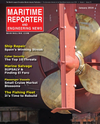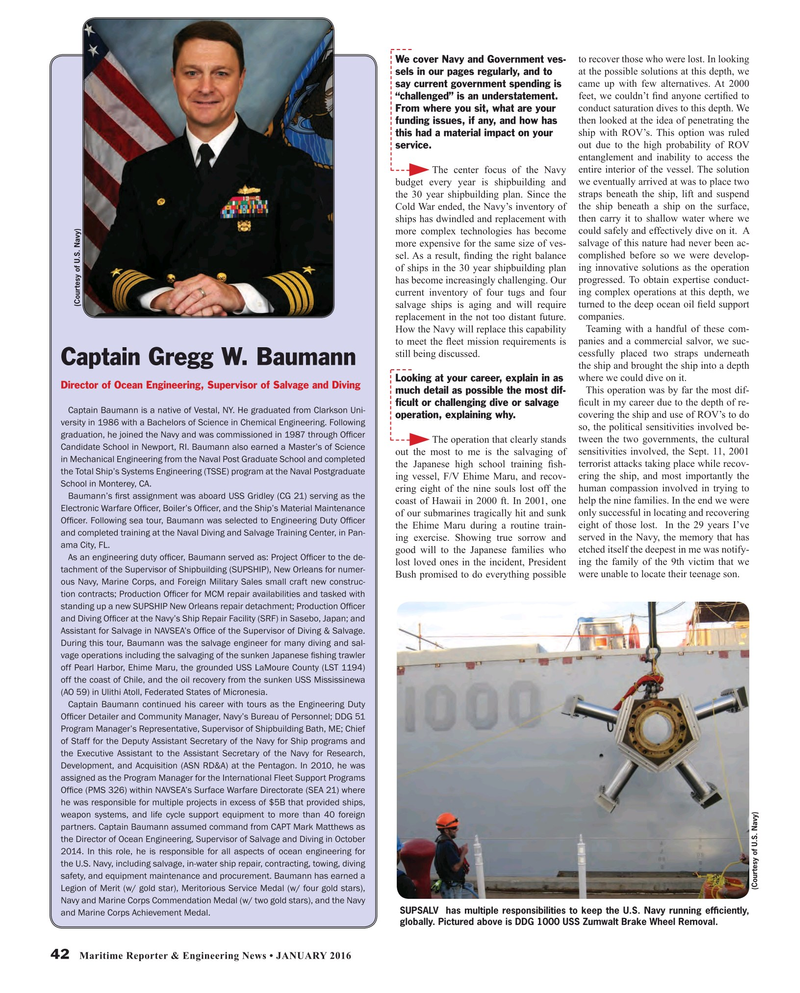
Page 42: of Maritime Reporter Magazine (January 2016)
Ship Repair & Conversion Edition
Read this page in Pdf, Flash or Html5 edition of January 2016 Maritime Reporter Magazine
to recover those who were lost. In looking
We cover Navy and Government ves- at the possible solutions at this depth, we sels in our pages regularly, and to came up with few alternatives. At 2000 say current government spending is feet, we couldn’t ? nd anyone certi? ed to “challenged” is an understatement. conduct saturation dives to this depth. We
From where you sit, what are your then looked at the idea of penetrating the funding issues, if any, and how has ship with ROV’s. This option was ruled this had a material impact on your out due to the high probability of ROV service.
entanglement and inability to access the The center focus of the Navy entire interior of the vessel. The solution budget every year is shipbuilding and we eventually arrived at was to place two the 30 year shipbuilding plan. Since the straps beneath the ship, lift and suspend
Cold War ended, the Navy’s inventory of the ship beneath a ship on the surface, ships has dwindled and replacement with then carry it to shallow water where we more complex technologies has become could safely and effectively dive on it. A more expensive for the same size of ves- salvage of this nature had never been ac- sel. As a result, ? nding the right balance complished before so we were develop- of ships in the 30 year shipbuilding plan ing innovative solutions as the operation has become increasingly challenging. Our progressed. To obtain expertise conduct- current inventory of four tugs and four ing complex operations at this depth, we (Courtesy of U.S. Navy) salvage ships is aging and will require turned to the deep ocean oil ? eld support replacement in the not too distant future. companies.
How the Navy will replace this capability Teaming with a handful of these com- to meet the ? eet mission requirements is panies and a commercial salvor, we suc- still being discussed. cessfully placed two straps underneath
Captain Gregg W. Baumann the ship and brought the ship into a depth where we could dive on it.
Looking at your career, explain in as
Director of Ocean Engineering, Supervisor of Salvage and Diving
This operation was by far the most dif- much detail as possible the most dif- ? cult in my career due to the depth of re- ? cult or challenging dive or salvage
Captain Baumann is a native of Vestal, NY. He graduated from Clarkson Uni- covering the ship and use of ROV’s to do operation, explaining why.
versity in 1986 with a Bachelors of Science in Chemical Engineering. Following so, the political sensitivities involved be- graduation, he joined the Navy and was commissioned in 1987 through Of? cer The operation that clearly stands tween the two governments, the cultural
Candidate School in Newport, RI. Baumann also earned a Master’s of Science out the most to me is the salvaging of sensitivities involved, the Sept. 11, 2001 in Mechanical Engineering from the Naval Post Graduate School and completed the Japanese high school training ? sh- terrorist attacks taking place while recov- the Total Ship’s Systems Engineering (TSSE) program at the Naval Postgraduate ing vessel, F/V Ehime Maru, and recov- ering the ship, and most importantly the
School in Monterey, CA.
ering eight of the nine souls lost off the human compassion involved in trying to
Baumann’s ? rst assignment was aboard USS Gridley (CG 21) serving as the coast of Hawaii in 2000 ft. In 2001, one help the nine families. In the end we were
Electronic Warfare Of? cer, Boiler’s Of? cer, and the Ship’s Material Maintenance of our submarines tragically hit and sunk only successful in locating and recovering
Of? cer. Following sea tour, Baumann was selected to Engineering Duty Of? cer the Ehime Maru during a routine train- eight of those lost. In the 29 years I’ve and completed training at the Naval Diving and Salvage Training Center, in Pan- ing exercise. Showing true sorrow and served in the Navy, the memory that has ama City, FL.
good will to the Japanese families who etched itself the deepest in me was notify-
As an engineering duty of? cer, Baumann served as: Project Of? cer to the de- lost loved ones in the incident, President ing the family of the 9th victim that we tachment of the Supervisor of Shipbuilding (SUPSHIP), New Orleans for numer-
Bush promised to do everything possible were unable to locate their teenage son. ous Navy, Marine Corps, and Foreign Military Sales small craft new construc- tion contracts; Production Of? cer for MCM repair availabilities and tasked with standing up a new SUPSHIP New Orleans repair detachment; Production Of? cer and Diving Of? cer at the Navy’s Ship Repair Facility (SRF) in Sasebo, Japan; and
Assistant for Salvage in NAVSEA’s Of? ce of the Supervisor of Diving & Salvage.
During this tour, Baumann was the salvage engineer for many diving and sal- vage operations including the salvaging of the sunken Japanese ? shing trawler off Pearl Harbor, Ehime Maru, the grounded USS LaMoure County (LST 1194) off the coast of Chile, and the oil recovery from the sunken USS Mississinewa (AO 59) in Ulithi Atoll, Federated States of Micronesia.
Captain Baumann continued his career with tours as the Engineering Duty
Of? cer Detailer and Community Manager, Navy’s Bureau of Personnel; DDG 51
Program Manager’s Representative, Supervisor of Shipbuilding Bath, ME; Chief of Staff for the Deputy Assistant Secretary of the Navy for Ship programs and the Executive Assistant to the Assistant Secretary of the Navy for Research,
Development, and Acquisition (ASN RD&A) at the Pentagon. In 2010, he was assigned as the Program Manager for the International Fleet Support Programs
Of? ce (PMS 326) within NAVSEA’s Surface Warfare Directorate (SEA 21) where he was responsible for multiple projects in excess of $5B that provided ships, weapon systems, and life cycle support equipment to more than 40 foreign partners. Captain Baumann assumed command from CAPT Mark Matthews as the Director of Ocean Engineering, Supervisor of Salvage and Diving in October 2014. In this role, he is responsible for all aspects of ocean engineering for the U.S. Navy, including salvage, in-water ship repair, contracting, towing, diving safety, and equipment maintenance and procurement. Baumann has earned a (Courtesy of U.S. Navy)
Legion of Merit (w/ gold star), Meritorious Service Medal (w/ four gold stars),
Navy and Marine Corps Commendation Medal (w/ two gold stars), and the Navy
SUPSALV has multiple responsibilities to keep the U.S. Navy running ef? ciently, and Marine Corps Achievement Medal.
globally. Pictured above is DDG 1000 USS Zumwalt Brake Wheel Removal.
42 Maritime Reporter & Engineering News • JANUARY 2016
MR #1 (42-49).indd 42 1/6/2016 11:29:32 AM

 41
41

 43
43
